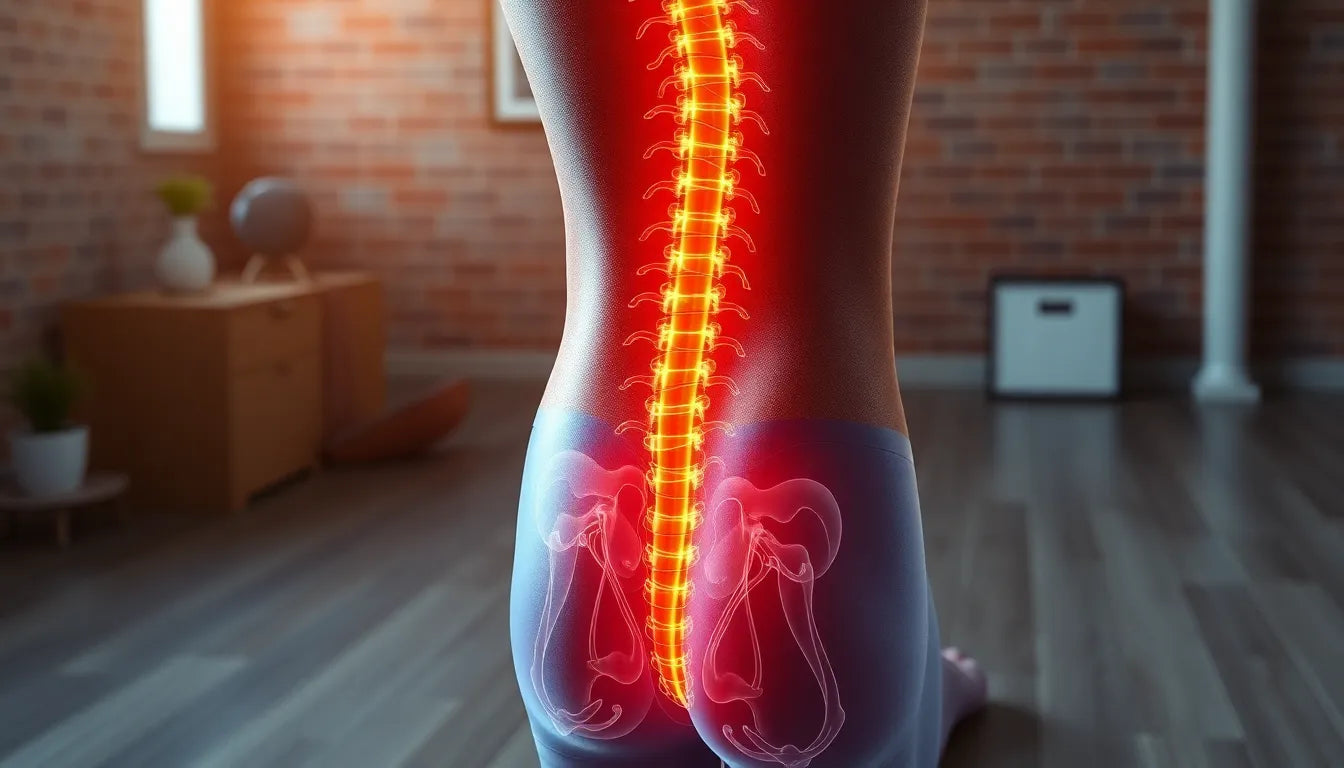Understanding hip bursitis is crucial for anyone experiencing discomfort in the hip area. Hip bursitis refers to the inflammation of the bursa, a small fluid-filled sac located near the hip joint. This inflammation can lead to significant pain and discomfort, often making simple movements challenging. Common symptoms include a sharp or burning pain on the outer part of the hip, tenderness, and swelling. These symptoms can intensify with prolonged activity, making it difficult to engage in regular daily activities.
Causes and impact of hip bursitis
Several factors can contribute to the development of hip bursitis. Repetitive stress on the hip joint, often from activities such as running or cycling, is a common cause. Injuries, whether from a fall or a direct blow to the hip, can also lead to inflammation. Additionally, overuse of the hip joint without adequate rest can exacerbate the condition. The impact of hip bursitis on daily life can be profound, as it may hinder one's ability to walk, climb stairs, or even sit comfortably for extended periods. This can significantly affect one's quality of life, emphasizing the need for effective management strategies.
The importance of exercise in managing hip bursitis
Exercise plays a pivotal role in managing hip bursitis. Engaging in targeted exercises can help alleviate pain, improve flexibility, and strengthen the muscles surrounding the hip joint. Strengthening these muscles is essential to provide better support to the hip, reducing the risk of further irritation to the bursa. Flexibility exercises, on the other hand, can help maintain a good range of motion, which is crucial for performing everyday tasks without pain. It's important to approach these exercises with caution and gradually increase intensity to prevent exacerbating the condition.

Women's Posture Shirt™ - Black
Patented posture shirt activates muscles and can relieve pain and promote postural awareness.
Are you ready to tackle hip pain?
Have you been experiencing persistent hip pain that disrupts your daily routine? You're not alone. Many people face similar challenges, but the good news is that there are effective solutions available. By incorporating specific hip bursitis exercises into your routine, you can take significant steps toward relieving pain and regaining mobility. Whether you're dealing with mild discomfort or more severe symptoms, these exercises can be a valuable part of your recovery strategy. Explore the exercises that can make a difference and take control of your hip health today.
Evidence-based exercises for hip bursitis
Addressing hip bursitis effectively requires a targeted approach, focusing on specific exercises that alleviate pain and enhance hip function. Here, we delve into evidence-based exercises that are instrumental in managing hip bursitis, each designed to target different muscle groups and improve overall hip stability.
Clamshell exercise
The clamshell exercise is pivotal for strengthening the gluteus medius and external rotators, crucial muscles for hip stability. To perform this exercise, lie on your side with your knees bent and feet together. Keeping your hips stable, lift the top knee as high as you comfortably can without rotating your pelvis. This movement should be controlled and slow, ensuring maximum engagement of the targeted muscles. Aim for 2-3 sets of 10-15 repetitions on each side to effectively build strength.
Glute stretch (lying/crossed)
Stretching the glutes can significantly reduce tension and discomfort associated with hip bursitis. For the lying glute stretch, lie on your back and gently pull one knee towards the opposite shoulder. Alternatively, for a deeper stretch, place your ankle on the opposite knee and press gently. Hold each stretch for 20-30 seconds, repeating 2-3 times per side to maintain flexibility and reduce muscle tightness.
IT band stretch
The iliotibial (IT) band stretch is essential for alleviating tension in the outer hip area. Stand upright and cross one leg behind the other, leaning your body towards a wall or stable surface. This stretch targets the IT band, helping to decrease lateral hip tension. Hold the stretch for 20-30 seconds and repeat 2-3 times per side to achieve optimal results.
Straight-leg raise
Straight-leg raises are effective for strengthening the hip muscles, particularly the hip flexors and stabilizers. Lie on your side and lift the top leg, keeping your hip aligned with your body. This exercise should be performed with control, focusing on maintaining proper form to maximize muscle engagement. Perform 2-3 sets of 10-15 repetitions on each side to build strength progressively.
Single-leg glute bridge
The single-leg glute bridge targets the gluteal muscles and core, both of which are vital for hip stability. Begin by lying on your back with one leg bent and the other extended. Push through the heel of the bent leg to lift your hips off the ground, forming a straight line from your shoulders to your knees. This exercise not only strengthens the glutes but also enhances core stability. Complete 2-3 sets of 10-15 repetitions per side, focusing on controlled movements and proper form.
Clinical and scientific context
Scientific research underscores the importance of both isometric and isotonic exercises in managing greater trochanteric pain syndrome, a common manifestation of hip bursitis. Studies indicate that these exercises can significantly improve pain and function over a 12-week period. Incorporating a mix of static and dynamic movements allows for comprehensive muscle engagement and gradual strengthening.
Consistency is key in achieving the best outcomes from these exercises. A structured regimen, ideally over three months, is recommended for substantial improvement. Engaging in regular physical therapy sessions can also enhance recovery, as individualized plans often yield better results than unsupervised routines. Monitoring symptoms and adjusting exercises as needed ensures that the rehabilitation process is both effective and safe.
By integrating these exercises into your routine, you can actively manage hip bursitis, reducing pain and improving your quality of life. Remember, gradual progression and consistency are crucial, and consulting with a healthcare professional can provide additional guidance tailored to your specific needs.
Advanced exercises for hip bursitis relief
Building on the foundational exercises previously discussed, incorporating advanced and supplementary exercises can further enhance hip strength, flexibility, and overall stability. These exercises are designed to challenge the muscles around the hip joint more intensively, promoting better support and reducing the risk of further irritation to the bursa.
Bridges
The bridge exercise is an excellent way to strengthen the gluteal muscles and core, providing essential support to the hip joint. To perform this exercise, lie on your back with your feet flat on the floor and knees bent. Engage your core and glutes to lift your hips towards the ceiling, forming a straight line from your shoulders to your knees. Hold briefly at the top before lowering back down. Aim for 2-3 sets of 10-15 repetitions, focusing on controlled movements.

Lumbar support belt
Provides adjustible stabilisation and relief for lower back pain and tension.
Standing isometrics ('push out')
Standing isometrics, often referred to as the "push out" exercise, activate the hip abductors, crucial for lateral stability. Stand with your feet hip-width apart and imagine spreading the floor apart with your feet without actually moving them. This action engages the hip muscles isometrically. Hold the position for 10-15 seconds and repeat 5 times. This exercise can be incorporated into daily routines to maintain muscle activation.
Sidesteps with bands
Sidesteps with resistance bands are a dynamic way to challenge the hip abductors further. Begin by placing a resistance band around your legs, either above the knees or at the ankles. Stand with feet shoulder-width apart and slightly bend your knees. Step sideways, maintaining tension in the band, and then bring the opposite foot in to return to the starting position. Perform 2-3 sets of 10-15 steps per side to effectively target the hip muscles.
Final thoughts on hip bursitis exercises
Progression and monitoring are key when incorporating these advanced exercises into your routine. Start with lower resistance or fewer repetitions, gradually increasing as your strength and comfort improve. It's crucial to listen to your body and adjust the intensity accordingly. If pain persists or worsens, consulting a healthcare professional is advised to ensure exercises are performed safely and effectively.
Frequently asked questions
Can exercise worsen hip bursitis?
Exercise can be beneficial if performed correctly. It's important to start slowly and consult with a healthcare professional before beginning any new exercise routine to ensure that exercises are appropriate for your condition.
How often should I perform these exercises?
Aim to perform these exercises 3-4 times a week, adjusting based on your personal comfort and improvement. Consistency is key to seeing benefits over time.
When should I seek medical advice?
If pain worsens or does not improve with exercise, it is advisable to consult a healthcare provider. They can offer tailored advice and modifications to your routine.
Are there any other treatments for hip bursitis?
Yes, other treatments may include physical therapy, medication, or in some cases, injections or surgery as advised by a healthcare professional. It's important to explore all options with your doctor to determine the best course of action for your situation.
Kilder
- Surrey Physio. (n.d.). "Best 5 Exercises for Hip Bursitis."
- Gombera, M.D. (n.d.). "4 Hip Bursitis Stretches and Exercises to Decrease Pain."
- Brisbane Spine Clinic. (n.d.). "Relief in Motion: Stretches and Exercises for Hip Bursitis."
- GoodRx. (n.d.). "Exercises for Hip Bursitis."
- SH Surgery. (n.d.). "Trochanteric Bursitis Exercise."
- MyHealth Alberta. (n.d.). "Hip Bursitis: Exercises."
- Kaiser Permanente. (n.d.). "Hip Bursitis Exercises."
- YouTube. (n.d.). "Hip Bursitis Exercises."
- YouTube. (n.d.). "Exercises for Hip Pain."


















